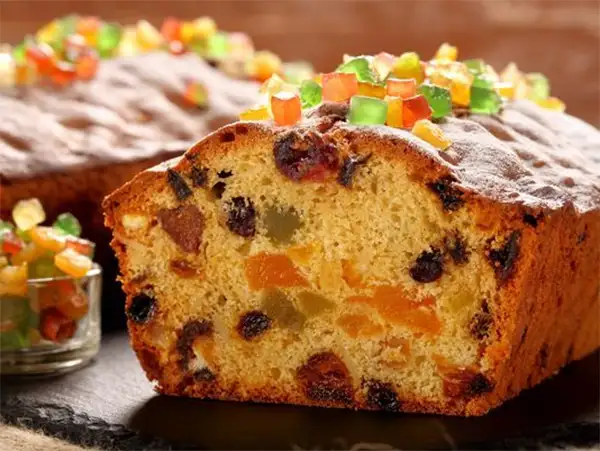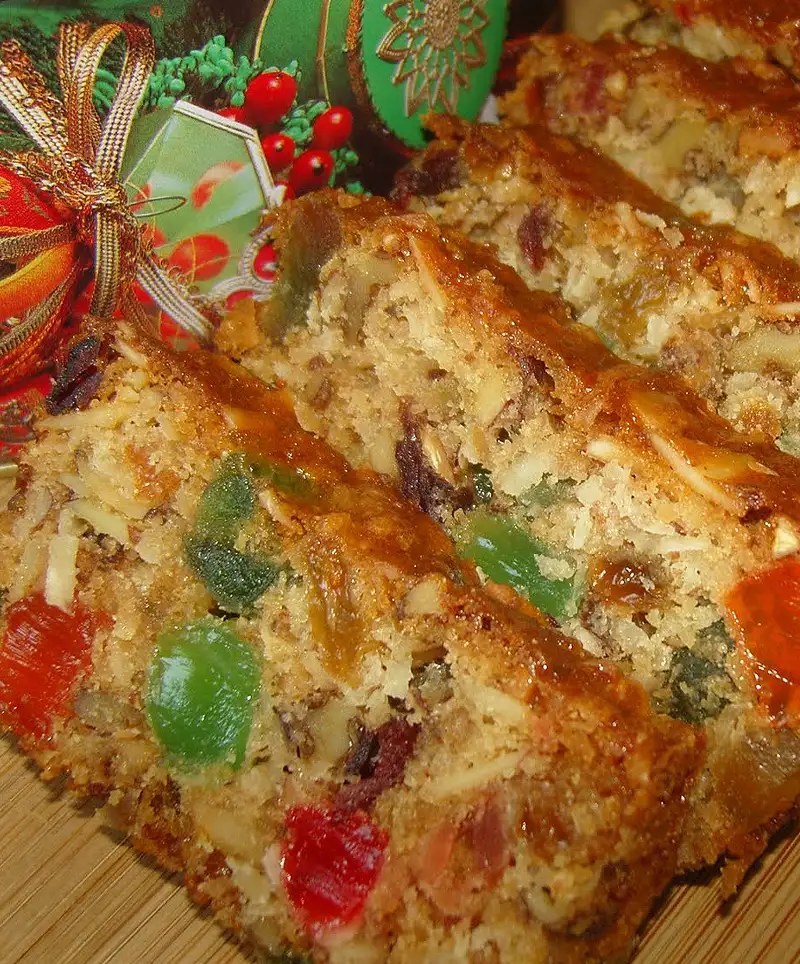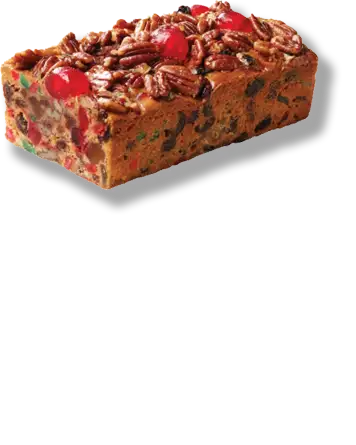A Slice of History and Holiday Lore for National Fruitcake Day
Ah, the fruitcake. It’s the holiday dessert that inspires equal parts nostalgia and confusion. Is it a dessert? A doorstop? A re-gifted heirloom? On National Fruitcake Day, celebrated every December 27, we pay homage to this storied loaf that has withstood the test of time—and possibly a nuclear apocalypse.
Origins of the Fruitcake
Fruitcake isn’t a modern invention. In fact, it has a history as rich as its dense texture. The origins of fruitcake date back to ancient Rome, where it was known as satura. Back then, it was more of a power bar for soldiers, consisting of pomegranate seeds, pine nuts, and barley mash. Imagine trying to bite into that during a battle—it probably hurt more than the enemy’s sword.
By the Middle Ages, dried fruits and spices became available, and fruitcake evolved into a luxury item reserved for royalty and the ultra-wealthy. In Victorian England, it was often served at weddings. Queen Victoria herself reportedly waited an entire year to eat a fruitcake she received for her birthday to demonstrate restraint. (She may have been the first person to start the tradition of letting fruitcakes age, though modern recipients don’t always have such noble intentions.)
What’s in a Fruitcake?
A fruitcake isn’t just a cake; it’s an edible museum exhibit. This dessert is packed with dried fruits, nuts, and spices, bound together by a rich, buttery batter that has a density rivaling a neutron star. Traditional recipes call for raisins, currants, and sultanas, but modern bakers might get adventurous, throwing in dried apricots, figs, or even mango for a tropical twist.
Nuts play a starring role too, adding a delightful crunch to contrast the sticky sweetness of the dried fruit. Almonds, walnuts, and pecans are common choices, though regional variations might include pistachios or macadamias. Then there’s the spice mix, a medley of cinnamon, nutmeg, cloves, and allspice, which transforms the batter into something that smells like a warm holiday hug.
And, of course, we can’t forget the liquor. Whether it’s rum, brandy, or whiskey, a good fruitcake is lovingly doused in spirits—not just once, but repeatedly over weeks (or months) of aging. This boozy addition serves two purposes: it acts as a preservative and ensures that even if the fruitcake isn’t a crowd-pleaser, the guests will be merry enough not to care.
But let’s not overlook the pièce de résistance: the candied fruits. These are the neon jewels of the fruitcake world, ranging from green pineapple chunks to cherries so vibrantly red they might glow in the dark. These fruits are preserved in a sugary syrup that ensures their longevity, though no one can explain why they remain as soft and shiny as they were decades ago. They might be the dessert equivalent of the Mona Lisa—eternal and puzzling.
If you’re feeling ambitious, you can even modernize your fruitcake with unconventional ingredients like chocolate chips, espresso powder, or a drizzle of caramel. Just be careful not to stray too far from tradition, or your cake might start questioning its identity.
 Fruitcake is the Marmite of desserts: you either love it or think it should be launched into space. Its detractors argue that it’s too dense, too sweet, or too much of a commitment, given that a single slice weighs as much as a toddler. Its fans, however, celebrate its rich flavors, texture, and nostalgia. Fruitcake is also incredibly versatile. It can be eaten plain, toasted, or soaked in enough brandy to ensure you don’t remember the relatives who brought it over.
Fruitcake is the Marmite of desserts: you either love it or think it should be launched into space. Its detractors argue that it’s too dense, too sweet, or too much of a commitment, given that a single slice weighs as much as a toddler. Its fans, however, celebrate its rich flavors, texture, and nostalgia. Fruitcake is also incredibly versatile. It can be eaten plain, toasted, or soaked in enough brandy to ensure you don’t remember the relatives who brought it over.
Fruitcake Across the Globe
Fruitcake isn’t just an American phenomenon; it’s a global affair with regional variations that showcase its versatility and adaptability. While the ingredients may change, the core concept of a dense, fruit-laden, and occasionally boozy dessert remains the same.
In Germany, the beloved cousin of the fruitcake is stollen, a sweet bread-like cake studded with dried fruits, nuts, and marzipan. Dusted generously with powdered sugar, it’s meant to resemble the swaddling clothes of the baby Jesus, making it a deeply symbolic holiday treat. Stollen is traditionally aged for several weeks to enhance its flavor—though impatient holiday revelers often dive in early.
In Italy, panettone takes the spotlight during Christmas. Unlike the dense fruitcakes of other regions, panettone is delightfully airy, thanks to its yeast-leavened dough. Infused with citrus zest, dried fruits, and a hint of vanilla, it’s often served alongside coffee or wine, proving that Italians even make fruitcake chic. Variations like pandoro (a fruit-free, golden sponge cake) cater to those who love the concept but not the fruit.
In the Caribbean, fruitcake transforms into rum cake, a tropical take on the traditional loaf. Packed with dried fruits that are soaked in rum for days—sometimes weeks—this version is as much about the spirits as it is about the cake. The batter is often enriched with molasses or brown sugar, giving it a dark, caramelized flavor. Rum cake isn’t just a dessert; it’s a cultural experience, served with gusto at every major celebration.
Meanwhile, in England, fruitcake remains a quintessential part of weddings and holidays. Traditional English fruitcakes are heavy on dried fruits like currants, sultanas, and raisins, with a generous splash of brandy or sherry. These cakes are often elaborately decorated with marzipan and royal icing for formal occasions, making them as much a centerpiece as a dessert.
In Australia, fruitcake is a year-round treat but holds special significance during Christmas. Aussie fruitcakes often include glacé cherries, dried apricots, and macadamia nuts, giving them a local twist. They’re a favorite at outdoor holiday gatherings, paired with a cold beer or iced tea to combat the summer heat.
In Japan, the fruitcake has undergone a minimalist makeover. Japanese versions are typically lighter and less dense, with just a sprinkling of dried fruits and a touch of sweetness. They’re a nod to the Western tradition but adapted to suit Japanese tastes.
Even in the United States, regional variations abound. Southern-style fruitcakes often include pecans and bourbon, while Northern recipes might lean toward spices and molasses. Some families have passed down their fruitcake recipes for generations, with each loaf carrying the flavor of tradition—and just a hint of rebellion against fruitcake’s reputation.
From Europe to the Caribbean, Asia to the Americas, fruitcake proves it’s a global unifier. No matter where you are, there’s a version of fruitcake to suit your palate—whether you’re a devoted fan or cautiously curious. It’s a testament to human creativity and our shared desire to turn dried fruit and nuts into something extraordinary.
Fruitcake has earned its reputation as an enduring dessert—not just culturally, but physically. Thanks to its dense composition and preservation methods, fruitcakes can last for decades. In fact, the world’s oldest fruitcake, baked in 1878, is still intact (though not exactly appetizing). It’s on display in Michigan, where it serves as a monument to human ingenuity—or stubbornness.
How to Celebrate National Fruitcake Day
Celebrating National Fruitcake Day is all about embracing the quirks of this timeless dessert. Whether you’re a fruitcake fanatic or someone who appreciates its legendary status from a safe distance, there are plenty of ways to honor this holiday tradition with flair and creativity.
- Bake Your Own: Dust off Grandma’s recipe and get to work. Remember, the secret to a great fruitcake is starting in July.
- Host a Fruitcake Tasting: Gather friends and sample different varieties. Bonus points if you pair each one with a matching drink.
- Re-Gift with Pride: If you receive a fruitcake this holiday season, don’t hide it in shame. Pass it along to someone else! It’s the circle of fruitcake life.
- Join the Fruitcake Toss: Many towns host fruitcake-tossing contests, proving that even if you don’t love eating them, you can enjoy flinging them across a field.
On this National Fruitcake Day, let’s give the fruitcake its due. It’s more than just a punchline; it’s a culinary survivor, a symbol of the holidays, and a reminder that tradition—no matter how dense or brightly colored—binds us together. So, whether you bake one, taste one, or chuck one, raise a toast (and maybe a brandy-soaked slice) to the humble fruitcake. It may not be everyone’s favorite dessert, but it sure knows how to leave an impression.
Please Share our Content






 Fruitcake is the Marmite of desserts: you either love it or think it should be launched into space. Its detractors argue that it’s too dense, too sweet, or too much of a commitment, given that a single slice weighs as much as a toddler. Its fans, however, celebrate its rich flavors, texture, and nostalgia. Fruitcake is also incredibly versatile. It can be eaten plain, toasted, or soaked in enough brandy to ensure you don’t remember the relatives who brought it over.
Fruitcake is the Marmite of desserts: you either love it or think it should be launched into space. Its detractors argue that it’s too dense, too sweet, or too much of a commitment, given that a single slice weighs as much as a toddler. Its fans, however, celebrate its rich flavors, texture, and nostalgia. Fruitcake is also incredibly versatile. It can be eaten plain, toasted, or soaked in enough brandy to ensure you don’t remember the relatives who brought it over.








 "Sláinte!" is a traditional Irish expression used as a toast, equivalent to "Cheers!" in English.
"Sláinte!" is a traditional Irish expression used as a toast, equivalent to "Cheers!" in English.